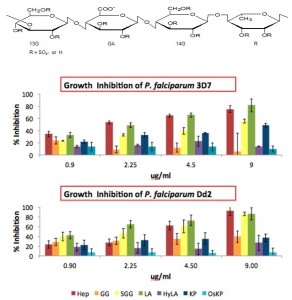Development of drug candidates for malaria Potential for antimalarial derived from novel material

Malaria affects millions of people globally, particularly in tropical regions. In recent years, concerted efforts to control the Anopheles mosquito vector and the broadened distribution of antimalarial drugs and diagnostic tools have led to improved conditions in malaria-endemic countries. Even though a malaria vaccine has yet to be developed, effective preventative and therapeutic medicines exist. Still, there is a continuing effort to develop preventive vaccines and discover novel compounds to address the constant threat of the Plasmodium parasites that cause malaria developing resistance to established antimalarial drugs.

© 2014 Kentaro Kato.
(Upper) Chemical structures of gellan gum and gellan sulfate (Bottom) In vitro growth inhibition of P. falciparum 3D7 and Dd2 in the presence of the following inhibitors: heparin (HEP), gellan gum (GG), gellan sulfate (SGG), λ-carrageenan (LA), hydrolyzed λ-carrageenan (HLA), κ-carrageenan (KP), and oversulfated κ-carrageenan (OSK).
One type of compounds that is attracting growing interest are novel polysaccharides, which may have therapeutic potential for treating or preventing malaria. In addition, polysaccharides modified, for example, by sulfation, phosphorylation and acetylation have also been assessed for possible medical applications.
In this study, Associate Professor Kentaro Kato and his group at the University of Tokyo Graduate School of Agricultural and Life Sciences and Obihiro University of Agriculture and Veterinary Medicine National Research Center for Protozoan Diseases showed for the first time that gellan sulfate, the sulfated derivative of gellan gum, a bacterial synthetic product used as a food additive, inhibits the in vitro growth and invasion of red blood cells by the human malaria parasite Plasmodium falciparum. In in vitro assays, they also showed that gellan sulfate has low cytotoxicity to human embryonic kidney cells and low anticoagulant activity.
As a result, gellan sulfate may be further assessed to determine its mechanisms of action as an antimalarial.
Paper
Frances Cagayat Recuenco, Kyousuke Kobayashi, Akiko Ishiwa, Yukiko Enomoto-Rogers, Noreen Grace V. Fundador, Tatsuki Sugi, Hitoshi Takemae, Tatsuya Iwanaga, Fumi Murakoshi, Haiyan Gong, Atsuko Inomata, Taisuke Horimoto, Tadahisa Iwata & Kentaro Kato,
“Gellan sulfate inhibits Plasmodium falciparum growth and invasion of red blood cells in vitro”,
Scientific Reports, Online Edition: 2014/4/18, doi: 10.1038/srep04723.
Article link
Links
Graduate School of Agricultural and Life Sciences
Department of Veterinary Medicine, Graduate School of Agricultural and Life Sciences
Laboratory of Veterinary Microbiology, Graduate School of Agricultural and Life Sciences (Japanese)







